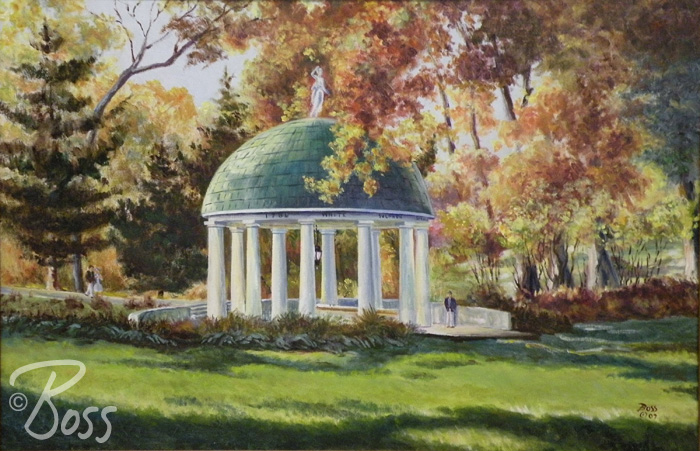
"the Vibrance of Fall: White Sulphur Springs, West Virginia"
by Michael Boss
Alkyd on Linen
20" X 30"
From a private collection, White Sulphur Springs, West Virginia
Nestled deep inside the majestic Allegheny Mountains in the Greenbrier region of West Virginia, you will find America's most storied luxury resort. The name and owners may have changed through the years yet one thing has stood for over two centuries as its iconic symbol: The Springhouse.
The healing powers of the flowing mineral water are steeped in Indian legend, and in 1778, a Mrs. Anderson tested its powers on her chronic rheumatism. News of her recovery spread. Before long a steady flow of visitors would find their way to the remote area to bath in the sulphur water and drink from the spring.
Michael Bowyer settled the area in 1784 and began the wilderness resort with just a few cabins and a tavern. After Michael's death, his son-in-law, James Calwell, of the prestigious Baltimore family, purchased most of the estate. He began to develop the property, attracting notable guests, selling cottages, many of which still stand today. In 1815 the first wooden, columned, square-roofed springhouse was built as an altar of health. In the early 1830s, Calwell built the springhouse we still see today.
The original statue atop the springhouse was Hygeia, the goddess of good health and medicine. Hygeia disappeared during the Civil War and was later replaced with the likeness of Hebe, the goddess of youth with the power of rejuvenation.
The meager cabins, once rented for the outrageous price of eight dollars a week, which included food, lodging and use of the waters, were transformed through the years into the South's grandest resort and would be known for 125 years as White Sulphur Springs.
Purchased in 1910 by the Chesapeake and Ohio Railway, major changes began. In 1914, The Greenbrier was born. The magnificently luxurious hotel has served U.S. Presidents, foreign dignitaries and royalty, along with Hollywood's top names. A premier tennis and golf destination, it was home to the first Ryder's Cup.
While various railroad companies have owned it for about a century of its prestigious life, the property actually survived a change in hands between the Confederate Army and the Union Army during the Civil War. During WWII, it housed hundreds of foreign diplomats and their families awaiting exchange of American diplomats, and then further served the war effort, treating over 24,000 soldiers, when it became the U.S. Army's Ashford General Hospital.
After the war, the C & O Railway reacquired the property from the government and began a major redecoration. Then in the late 1950s, the U.S. government came into play once again. Under cover of the on-going re-design, the Eisenhower Administration created a secret bunker. Strategically planned to house the entire U.S. government operations of Washington D.C. in case of attack, this Cold War fallout shelter was built under The Greenbrier and deep into the mountainside. For 30 years the bunker remained covert, literally underground, at constant readiness, until press exposure prompted it to be decommissioned in 1992.
Sitting on over 6500 beautiful Allegheny acres, The Greenbrier is an American symbol of renowned world-class grace, elegance, and tradition. Majestic and luxurious, with its four golf courses, tennis courts, swimming pools, sporting events and facilities, fine dining, designer shops, magnificent 5-Star/5-Diamond hotel with over 700 guestrooms with more than twice that many award-winning exceptional staff members, conference center, spa, and casino, is now a National Historic Landmark. Truly America's Resort, The Greenbrier's unparalled history is chronicled and shared personally through tours of this grand facility by its very own on-staff historian, Dr. Bob Conte.
And those miraculous 62 degree Fahrenheit waters under that famous historic domed springhouse still flow as steadily today, season after season, as they did in 1778.